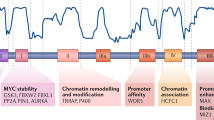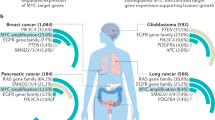Abstract
MYC proto-oncogene is a key player in cell homeostasis that is commonly deregulated in human carcinogenesis1. MYC can either activate or repress target genes by forming a complex with MAX (ref. 2). MYC also exerts MAX-independent functions that are not yet fully characterized3. Cells possess an intrinsic pathway that can abrogate MYC–MAX dimerization and E-box interaction, by inducing phosphorylation of MYC in a PAK2-dependent manner at three residues located in its helix–loop–helix domain4. Here we show that these carboxy-terminal phosphorylation events switch MYC from an oncogenic to a tumour-suppressive function. In undifferentiated cells, MYC–MAX is targeted to the promoters of retinoic-acid-responsive genes by its direct interaction with the retinoic acid receptor-α (RARα). MYC–MAX cooperates with RARα to repress genes required for differentiation, in an E-box-independent manner. Conversely, on C-terminal phosphorylation of MYC during differentiation, the complex switches from a repressive to an activating function, by releasing MAX and recruiting transcriptional co-activators. Phospho-MYC synergizes with retinoic acid to eliminate circulating leukaemic cells and to decrease the level of tumour invasion. Our results identify an E-box-independent mechanism for transcriptional regulation by MYC that unveils previously unknown functions for MYC in differentiation. These may be exploited to develop alternative targeted therapies.
This is a preview of subscription content, access via your institution
Access options
Subscribe to this journal
Receive 12 print issues and online access
$209.00 per year
only $17.42 per issue
Buy this article
- Purchase on Springer Link
- Instant access to full article PDF
Prices may be subject to local taxes which are calculated during checkout





Similar content being viewed by others
References
Meyer, N. & Penn, L. Z. Reflecting on 25 years with MYC. Nat. Rev. Cancer 8, 976–990 (2008).
Adhikary, S. & Eilers, M. Transcriptional regulation and transformation by Myc proteins. Nat. Rev. Mol. Cell Biol. 6, 635–645 (2005).
Gallant, P. & Steiger, D. Myc’s secret life without Max. Cell Cycle 8, 3848–3853 (2009).
Huang, Z., Traugh, J. A. & Bishop, J. M. Negative control of the Myc protein by the stress-responsive kinase Pak2. Mol. Cell. Biol. 24, 1582–1594 (2004).
Soucek, L. et al. Modelling Myc inhibition as a cancer therapy. Nature 455, 679–683 (2008).
Eilers, M. & Eisenman, R. N. Myc’s broad reach. Genes Dev. 22, 2755–2766 (2008).
Kiessling, A., Sperl, B., Hollis, A., Eick, D. & Berg, T. Selective inhibition of c-Myc/Max dimerization and DNA binding by small molecules. Chem. Biol. 13, 745–751 (2006).
Patel, J. H., Loboda, A. P., Showe, M. K., Showe, L. C. & McMahon, S. B. Analysis of genomic targets reveals complex functions of MYC. Nat. Rev. Cancer 4, 562–568 (2004).
Wingender, E., Dietze, P., Karas, H. & Knuppel, R. TRANSFAC: a database on transcription factors and their DNA binding sites. Nucleic Acids Res. 24, 238–241 (1996).
Frith, M. C. et al. Detection of functional DNA motifs via statistical over-representation. Nucleic Acids Res. 32, 1372–1381 (2004).
Wang, Z. Y. & Chen, Z. Acute promyelocytic leukemia: from highly fatal to highly curable. Blood 111, 2505–2515 (2008).
Altucci, L. & Gronemeyer, H. The promise of retinoids to fight against cancer. Nat. Rev. Cancer 1, 181–193 (2001).
Lehmann, S., Paul, C. & Torma, H. Retinoid receptor expression and its correlation to retinoid sensitivity in non-M3 acute myeloid leukemia blast cells. Clin. Cancer Res. 7, 367–373 (2001).
Amati, B. et al. Oncogenic activity of the c-Myc protein requires dimerization with Max. Cell 72, 233–245 (1993).
de The, H., Vivanco-Ruiz, M. M., Tiollais, P., Stunnenberg, H. & Dejean, A. Identification of a retinoic acid responsive element in the retinoic acid receptor beta gene. Nature 343, 177–180 (1990).
Forman, B. M., Casanova, J., Raaka, B. M., Ghysdael, J. & Samuels, H. H. Half-site spacing and orientation determines whether thyroid hormone and retinoic acid receptors and related factors bind to DNA response elements as monomers, homodimers, or heterodimers. Mol. Endocrinol. 6, 429–442 (1992).
Chen, J. D. & Evans, R. M. A transcriptional co-repressor that interacts with nuclear hormone receptors. Nature 377, 454–457 (1995).
Horlein, A. J. et al. Ligand-independent repression by the thyroid hormone receptor mediated by a nuclear receptor co-repressor. Nature 377, 397–404 (1995).
Kamei, Y. et al. A CBP integrator complex mediates transcriptional activation and AP-1 inhibition by nuclear receptors. Cell 85, 403–414 (1996).
Chakravarti, D. et al. Role of CBP/P300 in nuclear receptor signalling. Nature 383, 99–103 (1996).
Heinzel, T. et al. A complex containing N-CoR, mSin3 and histone deacetylase mediates transcriptional repression. Nature 387, 43–48 (1997).
Karagianni, P. & Wong, J. HDAC3: taking the SMRT-N-CoRrect road to repression. Oncogene 26, 5439–5449 (2007).
Kurland, J. F. & Tansey, W. P. Myc-mediated transcriptional repression by recruitment of histone deacetylase. Cancer Res. 68, 3624–3629 (2008).
Nowak, D., Stewart, D. & Koeffler, H. P. Differentiation therapy of leukemia: 3 decades of development. Blood 113, 3655–3665 (2009).
Villa, R. et al. Epigenetic gene silencing in acute promyelocytic leukemia. Biochem. Pharmacol. 68, 1247–1254 (2004).
Grant, S. Ara-C: cellular and molecular pharmacology. Adv. Cancer Res. 72, 197–233 (1998).
Mosier, D. E., Gulizia, R. J., Baird, S. M. & Wilson, D. B. Transfer of a functional human immune system to mice with severe combined immunodeficiency. Nature 335, 256–259 (1988).
Jung, J. H. & Traugh, J. A. Regulation of the interaction of Pak2 with Cdc42 via autophosphorylation of serine 141. J. Biol. Chem. 280, 40025–40031 (2005).
Eilers, M., Picard, D., Yamamoto, K. R. & Bishop, J. M. Chimaeras of myc oncoprotein and steroid receptors cause hormone-dependent transformation of cells. Nature 340, 66–68 (1989).
Littlewood, T. D., Hancock, D. C., Danielian, P. S., Parker, M. G. & Evan, G. I. A modified oestrogen receptor ligand-binding domain as an improved switch for the regulation of heterologous proteins. Nucleic Acids Res. 23, 1686–1690 (1995).
Yu, V. C. et al. RXR beta: a coregulator that enhances binding of retinoic acid, thyroid hormone, and vitamin D receptors to their cognate response elements. Cell 67, 1251–1266 (1991).
Buschbeck, M. et al. PML4 induces differentiation by Myc destabilization. Oncogene 26, 3415–3422 (2007).
Di Croce, L. et al. Methyltransferase recruitment and DNA hypermethylation of target promoters by an oncogenic transcription factor. Science 295, 1079–1082 (2002).
Bour, G. et al. Cyclin H binding to the RARα activation function (AF)-2 domain directs phosphorylation of the AF-1 domain by cyclin-dependent kinase 7. Proc. Natl Acad. Sci. USA 102, 16608–16613 (2005).
Morey, L. et al. MBD3, a component of the NuRD complex, facilitates chromatin alteration and deposition of epigenetic marks. Mol. Cell. Biol. 28, 5912–5923 (2008).
Frank, S. R., Schroeder, M., Fernandez, P., Taubert, S. & Amati, B. Binding of c-Myc to chromatin mediates mitogen-induced acetylation of histone H4 and gene activation. Genes Dev. 15, 2069–2082 (2001).
Buschbeck, M. et al. The histone variant macroH2A is an epigenetic regulator of key developmental genes. Nat. Struct. Mol. Biol. 16, 1074–1079 (2009).
Flicek, P. et al. Ensembl’s 10th year. Nucleic Acids Res. 38, D557–D562 (2010).
Acknowledgements
We thank T. Berg and C. Rochette-Egly for reagents, P. Muñoz-Cánoves, S. de la Luna and G. Gil for discussions, S. Colomer-Lahiguera and J. Douet for graphical assistance, V. Valero for technical support and V. A. Raker for helpful discussions about the manuscript. This work was supported by grants from the ‘Fondo de Investigación Sanitario’ (FIS, Spanish Ministerio de Sanidad) to S.A.B.; and from the Spanish ‘Ministerio de Educación y Ciencia’, AGAUR and ‘Fundació La Marató’ to L.D.C. I.U. has been supported by an FPI fellowship of the Spanish Ministerio de Ciencia y Educación, M.B. by a DFG and a Ramón y Cajal fellowship, S.T. by a ‘La Caixa’ fellowship and S.D. by a PFIS fellowship.
Author information
Authors and Affiliations
Contributions
I.U. and M.B. carried out reporter assays, co-immunoprecipitations and ChIPs; I.U. and A.G. conducted cellular infections, flow cytometry analyses and gene expression experiments as well as differentiation studies with assistance from J.F.N; I.U., M.B., S.T. and S.D. carried out recombinant protein expression, pulldown experiments and phosphorylation assays; B.K. carried out Flag-affinity purification and generated HEK293T MYC–ER stable clones; J.M-C. carried out the experimental work on mice, assisted by I.U. and A.G.; G.R. carried out all bioinformatic analyses; L.D.C., S.A.B. and I.U. supervised the project and designed the experiments; I.U., M.B., S.A.B. and L.D.C. wrote the manuscript.
Corresponding authors
Ethics declarations
Competing interests
The authors declare no competing financial interests.
Supplementary information
Supplementary Information
Supplementary Information (PDF 1362 kb)
Supplementary Table 1
Supplementary Information (XLS 976 kb)
Supplementary Table 2
Supplementary Information (XLS 34 kb)
Supplementary Table 3
Supplementary Information (XLS 114 kb)
Supplementary Table 4
Supplementary Information (XLS 174 kb)
Rights and permissions
About this article
Cite this article
Uribesalgo, I., Buschbeck, M., Gutiérrez, A. et al. E-box-independent regulation of transcription and differentiation by MYC. Nat Cell Biol 13, 1443–1449 (2011). https://doi.org/10.1038/ncb2355
Received:
Accepted:
Published:
Issue Date:
DOI: https://doi.org/10.1038/ncb2355
This article is cited by
-
MYC: a multipurpose oncogene with prognostic and therapeutic implications in blood malignancies
Journal of Hematology & Oncology (2021)
-
Isolation, characterization, and expression of proto-oncogene cMyc in large yellow croaker Larimichthys crocea
Fish Physiology and Biochemistry (2017)
-
Redeployment of Myc and E2f1–3 drives Rb-deficient cell cycles
Nature Cell Biology (2015)
-
ZRF1 controls the retinoic acid pathway and regulates leukemogenic potential in acute myeloid leukemia
Oncogene (2014)
-
MYC oncogene in myeloid neoplasias
Clinical and Translational Oncology (2013)



